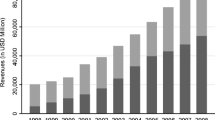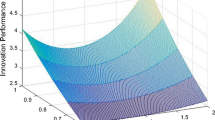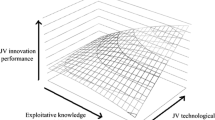Abstract
We analyzed the relationship between exploration-oriented and exploration-oriented alliances. Through the complementarity approach, three possible relationships were analyzed: complementarity, substitutability, and no relationship. We use Technological Innovation Panel data for Spanish manufacturing firms for 2005–2013. The econometric technique that we used to estimate the coefficients was population-averaged OLS. Our findings suggest that alliance portfolios formed by exploration-oriented and exploration-oriented alliances achieve worse innovation performance than specialized exploration or exploitation portfolios. In addition, we found that a single class of alliance has different impacts on innovation performance depending on whether it is implemented by a young company or a mature company.
Similar content being viewed by others
References
Abernathy, W. J. (1978). The productivity dilemma: roadblock to innovation in the automobile industry. Baltimore: Johns Hopkins University Press.
Ahuja, G. (2000). The duality of collaboration: inducements and opportunities in the formation of inter-firm linkages. Strategic Management Journal, 21(3), 317–343.
Atuahene-Gima, K. (2005). Resolving the capability: rigidity paradox in new product innovation. Journal of Marketing,69(4), 61–83.
Ballot, G., Fakhfakh, F., Galia, F., & Salter, A. (2015). The fateful triangle. Complementarities between product, process and organizational innovation in the UK and France. Research Policy,44(1), 217–232.
Belderbos, R., Carree, M., & Lokshin, B. (2006). Complementarity in R&D cooperation strategies. Review of Industrial Organization,28(4), 401–426.
Boumgarden, P., Nickerson, J., & Zenger, T. R. (2012). Sailing into the wind: exploring the relationships among ambidexterity, vacillation, and organizational performance. Strategic Management Journal,33(6), 587–610.
Branstetter, L. G., & Sakakibara, M. (2002). When do research consortia work well and why? Evidence from Japanese panel data. The American Economic Review,92(1), 143–159.
Broekel, T., & Graf, H. (2012). Public research intensity and the structure of German R&D networks: a comparison of 10 technologies. Economics of Innovation and New Technology,21(4), 345–372.
Brown, S. L., & Eisenhardt, K. M. (1995). Product development: past research, present findings, and future directions. Academy of Management Review,20(2), 343–378.
Cao, Q., Gedajlovic, E., & Zhang, H. (2009). Unpacking organizational ambidexterity: dimensions, contingencies, and synergistic effects. Organization Science,20(4), 781–796.
Cassiman, B., & Veugelers, R. (2006). In search of complementarity in the innovation strategy: internal R&D and external knowledge acquisition. Management Science,52(1), 68–82.
Choi, Y. R., & Phan, P. H. (2014). Exploration, exploitation, and growth through new product development: the moderating effects of firm age and environmental adversity. IEEE Transactions on Engineering Management,61(3), 428–437.
Coad, A., & Guenther, C. (2013). Diversification patterns and survival as firms mature. Small Business Economics,41(3), 633–649.
Coad, A., Segarra, A., & Teruel, M. (2016). Innovation and firm growth: does firm age play a role? Research Policy,45(2), 387–400.
Cohen, W. M., & Levinthal, D. A. (1990). A new perspective on learning and innovation. Administrative Science Quarterly,3(1), 128–152.
Colombo, M. G., Doganova, L., Piva, E., D’Adda, D., & Mustar, P. (2015). Hybrid alliances and radical innovation: the performance implications of integrating exploration and exploitation. The Journal of technology Transfer,40(4), 696–722.
Czarnitzki, D., Ebersberger, B., & Fier, A. (2007). The relationship between R&D collaboration, subsidies and patenting activity: empirical evidence from Finland and Germany. Journal of Applied Econometrics,22(7), 1347–1366.
Damanpour, F., Walker, R. M., & Avellaneda, C. N. (2009). Combinative effects of innovation types and organizational performance: a longitudinal study of service organizations. Journal of Management Studies,46(4), 650–675.
Das, T. K., & Teng, B. S. (1998). Between trust and control: developing confidence in partner cooperation in alliances. Academy of Management Review,23(3), 491–512.
Das, T. K., & Teng, B. S. (2000). A resource based theory of strategic alliances. Journal of Management,26(1), 31–61.
Deeds, D. L., & Hill, C. W. (1996). Strategic alliances and the rate of new product development: an empirical study of entrepreneurial biotechnology firms. Journal of Business Venturing, 11(1), 41–55.
Duncan, R. B. (1976). The ambidextrous organization: designing dual structures for innovation. The Management of Organization Design,1, 167–188.
Faems, D., Janssens, M., Madhok, A., & Van Looy, B. (2008). Toward an integrative perspective on alliance governance: connecting contract design, contract application, and trust dynamics. Academy of Management Journal,51(6), 1053–1078.
Faems, D., Van Looy, B., & Debackere, K. (2005). Interorganizational collaboration and innovation: toward a portfolio approach. Journal of Product Innovation Management,22(3), 238–250.
Gibson, C. B., & Birkinshaw, J. (2004). The antecedents, consequences, and mediating role of organizational ambidexterity. Academy of Management Journal,47(2), 209–226.
Guisado-González, M., Wright, L. T., & Guisado-Tato, M. (2015). Product–process matrix and complementarity approach. The Journal of Technology Transfer. https://doi.org/10.1007/s10961-015-9435-6.
Gupta, A. K., Smith, K. G., & Shalley, C. E. (2006). The interplay between exploration and exploitation. Academy of Management Journal,49(4), 693–706.
Hannan, M. T., & Freeman, J. (1984). Structural inertia and organizational change. American Sociological Review,49(2), 149–164.
He, Z. L., & Wong, P. K. (2004). Exploration vs. exploitation: an empirical tests of the ambidexterity hypothesis. Organization Science,15(4), 481–494.
Jansen, J. J. P., Tempelaar, M. P., Van den Bosch, F. A. J., & Volberda, H. W. (2009). Structural differentiation and ambidexterity: the mediating role of integration mechanisms. Organization Science,20(4), 797–811.
Koza, M. P., & Lewin, A. Y. (1998). The co-evolution of strategic alliances. Organization Science,9(3), 255–264.
Laursen, K., Leone, M. I., & Torrisi, S. (2010). Technological exploration through licensing: new insights from the licensee’s point of view. Industrial and Corporate Change,19(3), 871–897.
Lavie, D., Kang, J., & Rosenkopf, L. (2011). Balance within and across domains: the performance implications of exploration and exploitation in alliances. Organization Science,22(6), 1517–1538.
Levin, R. C., Klevorick, A. K., Nelson, R. R., & Winter, S. G. (1987). Appropriating the returns from industrial research and development. Brookings Papers on Economic Activity, 3, 783–820.
Lavie, D., Lechner, C., & Singh, H. (2007). The performance implications of timing of entry and involvement in multipartner alliances. Academy of Management Journal,50(3), 578–604.
Lavie, D., & Rosenkopf, L. (2006). Balancing exploration and exploitation in alliance formation. Academy of Management Journal,49(4), 797–818.
Lavie, D., Stettner, U., & Tushman, M. L. (2010). Exploration and exploitation within and across organizations. The Academy of Management Annals,4(1), 109–155.
Leung, V. K. K., Keung, M Ch., Zhang, Z., & Gu, F. F. (2015). Explorative versus exploitative alliances: evidence from the glass industry in China. Journal of Chinese Economic and Business Studies,13(2), 127–146.
Levinthal, D. A., & March, J. G. (1993). The myopia of learning. Strategic Management Journal,14, 95–112.
Lewin, A. Y., Long, C. P., & Carroll, T. N. (1999). The coevolution of new organizational forms. Organization Science,10(5), 535–550.
Lubatkin, M. H., Simsek, Z., Ling, Y., & Veiga, J. F. (2006). Ambidexterity and performance in small- to medium-sized firms: the pivotal role of top management team behavioral integration. Journal of Management,32(5), 646–672.
March, J. G. (1991). Exploration and exploitation in organizational learning. Organization Science,2(1), 71–87.
McNamara, P., & Baden-Fuller, C. (2007). Shareholder returns and the exploration-exploitation dilemma: R&D announcements by biotechnology firms. Research Policy,36(4), 548–565.
Milgrom, P., & Roberts, J. (1990). The economics of modern manufacturing: technology, strategy, and organization. American Economic Review,80, 511–528.
Miotti, L., & Sachwald, F. (2003). Co-operative R&D: why and with whom? An integrated framework of analysis. Research Policy,32(8), 1481–1499.
Mohnen, P., & Röller, L. (2005). Complementarities in innovation policy. European Economic Review,49(6), 1431–1450.
O’Reilly, C. A., & Tushman, M. L. (2004). The ambidextrous organization. Harvard Business Review,82(4), 74–81.
O’Reilly, C. A., & Tushman, M. L. (2008). Ambidexterity as a dynamic capability: resolving the innovator’s dilemma. Research in Organizational Behaviour,28, 185–206.
Park, S. H., Chen, R., & Gallagher, S. (2002). Firm resources as moderators of the relationship between market growth and strategic alliances in semiconductor start-ups. Academy of Management Journal,45(3), 527–545.
Park, N. K., Mezias, J. M., & Song, J. A. (2004). Resource-based view of strategic alliances and firm value in the electronic marketplace. Journal of Management,30(1), 7–27.
Pinto, P. E., Hine, D. & Knights, P. (2011). Types and traps: R&D consortia and developmental pitfalls. DRUID Society Conference 2011 on Innovation, Strategy and Structure—Organizations, Institutions, Systems and Regions, Copenhagen, Denmark.
Porter, M. E. (1980). Competitive strategy: techniques for analyzing industries and competitors. New York: Free Press.
Puhan, T. X. (2008). Balancing exploration and exploitation by creating organizational think tanks. Wiesbaden: Gabler Edition Wissenschaft.
Raisch, S., & Birkinshaw, J. (2008). Organizational ambidexterity: antecedents, outcomes, and moderators. Journal of Management,34(3), 375–409.
Raisch, S., Birkinshaw, J., Probst, G., & Tushman, M. L. (2009). Organizational ambidexterity: balancing exploitation and exploration for sustained performance. Organization Science,20(4), 685–695.
Rivkin, J. W., & Siggelkow, N. (2003). Balancing search and stability: interdependencies among elements or organizational design. Management Science,49(3), 290–311.
Rosenkopf, L., & McGrath, P. (2011). Advancing the conceptualization and operationalization of novelty in organizational research. Organization Science,22(5), 1297–1311.
Rothaermel, F. T. (2001). Complementary assets, strategic alliances, and the incumbent’s advantage: an empirical study of industry and firm effects in the biopharmaceutical industry. Research Policy,30(8), 1235–1251.
Rothaermel, F. T., & Alexandre, M. T. (2009). Ambidexterity in technology sourcing: the moderating role of absorptive capacity. Organization Science,20(4), 759–780.
Rothaermel, F. T., & Deeds, D. L. (2004). Exploration and exploitation Alliances in biotechnology: a system of new product development. Strategic Management Journal,25(3), 201–221.
Sidhu, J. S., Commandeur, H. R., & Volberda, H. W. (2007). The multifaceted nature of exploration and exploitation: value of supply, demand, and spatial search for innovation. Organization Science,18(1), 20–38.
Smith, K. G., Collins, C. J., & Clark, K. D. (2005). Existing knowledge, knowledge creation capability, and the rate of new product introduction in high-technology firms. Academy of Management Journal, 48(2), 346–357.
Sørensen, J. B., & Stuart, T. E. (2000). Aging, obsolescence, and organizational innovation. Administrative Science Quarterly,45(1), 81–112.
Stuart, T. E. (2000). Interorganizational alliances and the performance of firms: a study of growth and innovation rates in a high-technology industry. Strategic Management Journal, 21(8), 791–811.
Stettner, U., & Lavie, D. (2014). Ambidexterity under Scrutiny: exploration and exploitation via internal organization, alliances, and acquisitions. Strategic Management Journal,35(13), 1903–1929.
Stinchcombe, A. L. (1965). Social structure and organizations. In J. G. March (Ed.), Handbook of organizations (pp. 142–193). Chicago: Rand McNally.
Sutton, J. (1997). Gibrat’s legacy. Journal of Economic Literature,35(1), 40–59.
Teece, D. J. (2002). Managing intellectual capital. Oxford: Oxford University Press.
Topkis, D. M. (1978). Minimizing a submodular function on a lattice. Operations Research,26(2), 305–321.
Tripsas, M. (1997). Unraveling the process of creative destruction: complementary assets and incumbent survival in the typesetter industry. Strategic Management Journal,18, 119–142.
Tushman, M., & Nadler, D. (1986). Organizing for innovation. California Management Review,28(3), 74–92.
Uotila, J., Maula, M., Keil, T., & Zahra, S. A. (2009). Exploration, exploitation, and financial performance: analysis of S&P 500 corporations. Strategic Management Journal,30(2), 221–231.
Van den Bosch, F. A. J., Volberda, H. W., & de Boer, M. (1999). Coevolution of firm absorptive capacity and knowledge environment: organizational forms and combinative capabilities. Organization Science, 10(5), 551–568.
Venkatraman, N., Lee, C. H., & Iyer, B. (2007). Strategic ambidexterity and sales growth: a longitudinal test in the software sector. Unpublished manuscript. Boston University Boston, MA.
Volery, T., Mueller, S., & Von Siemens, B. (2015). Entrepreneur ambidexterity: a study of entrepreneur behaviours and competencies in growth-oriented small and medium-sized enterprises. International Small Business Journal,33(2), 109–129.
Voss, G. B., Sirdeshmukh, D., & Voss, Z. G. (2008). The effects of slack resources and environmental threat on product exploration and exploitation. Academy of Management Journal,51(1), 147–164.
Voss, G. B., & Voss, Z. G. (2013). Strategic ambidexterity in small and medium-sized enterprises: implementing exploration and exploitation in product and market domains. Organization Science,24(5), 1459–1477.
Wagner, J. (2004). Are young and small firms hothouses for nascent entrepreneurs? Evidence from German micro data. Applied Economics Quarterly,50(4), 379–391.
Wheelwright, S. C., & Clark, K. B. (1992). Revolutionizing product development: quantum leaps in speed, efficiency and quality. New York: The Free Press.
Yamakawa, Y., Haibin Yang, H., & Linc, Z. (2011). Exploration versus exploitation in alliance portfolio: performance implications of organizational, strategic, and environmental fit. Research Policy,40(2), 287–296.
Zhang, J. (2016). Facilitating exploration alliances in multiple dimensions: the influences of firm technological knowledge breadth. R&D Management,46, 159–173.
Author information
Authors and Affiliations
Corresponding author
Additional information
Publisher's Note
Springer Nature remains neutral with regard to jurisdictional claims in published maps and institutional affiliations.
Rights and permissions
About this article
Cite this article
Guisado-González, M., González-Blanco, J. & Coca-Pérez, J.L. Exploration, exploitation, and firm age in alliance portfolios. Eurasian Bus Rev 9, 387–406 (2019). https://doi.org/10.1007/s40821-019-00131-y
Received:
Revised:
Accepted:
Published:
Issue Date:
DOI: https://doi.org/10.1007/s40821-019-00131-y




